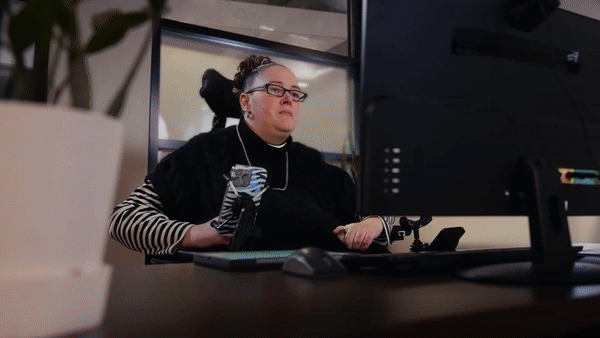Written by: Julia Franklin, CLO
We witness the transformative power of voice technology in enhancing how individuals interact with the digital world. Our users continue to discover innovative ways to utilize our voice controls & dictation, making everyday tasks simpler and more efficient. From navigating applications to customizing commands for unique speech patterns, the creative use cases shared by our community illustrate how voice technology can redefine accessibility in our daily lives.
In a recent survey we conducted that focused on assistive technology (AT) users, we found that over 50% of respondents used voice software/dictation for work- on top of that over 80% of respondents found that their access to this technology made their productivity increase or greatly increase.
What are some of the benefits Cephable users find with our innovative voice controls?
1. Streamlining Form Filling: One user created voice controls to have Cephable type back common phrases that he uses to fill forms for work, making repetitive tasks easier.
“With the new form filler voice controls, I can say a word or phrase, and Cephable types out commonly used text like my first name, last name, work email, or title. It saves me so much time!” -Rex


2. Effortless App Navigation: With the recent release of our global controls, many of our users talk about how they can now easily open apps on their computer using their voice, enhancing efficiency and productivity while multitasking.
3. Combining Hardware and Software: Another user shared his experience of using Cephable alongside his traditional hardware:
“I’ve been using my joystick for pointer activities, and then using voice for actions like ‘click.’ It’s been smooth. I like the combination—using my joystick for movement and voice for clicks.”
4. Enhanced Document Navigation: Nicole utilizes Cephable’s voice controls to navigate documents:
“Using Cephable’s voice controls, I can jump word to word or line to line in my documents, which saves me from the strain of mouse overuse.”
5. Customized Voice Commands: Cephable accommodates unique speech patterns, allowing users to customize their commands:
“I can use voice commands without the /s/ sounds because it’s harder for me to articulate those words.”
6. Gaming Accessibility: For gamers, Cephable opens up new possibilities & creative workarounds. Alan & Dayton note the software’s impact on their setup:
“This really makes my previous voice software obsolete. I was using that for some games, but now I can create as many commands as I need in Cephable.” – Alan
“I had an issue accessing a prompt in a game and thought, ‘Wait, I have Cephable.’ I turned on Microsoft Word, dictated what I needed, and then pasted it in to get past the screen where I was blocked. It was the only way that would have worked!” – Dayton
Beyond Our Users: The Global Need for Accessibility
At Cephable, we’re committed to enhancing our technology based on user feedback, ensuring that we meet the evolving needs of our community. By working together, we are shifting the accessibility paradigm and building a future where everyone can engage with technology in meaningful and effective ways. Our users offer real insights into how these tools are reshaping their daily experiences—not only for work but for personal engagement too. These stories highlight how accessibility is deeply personal and adaptable to meet a variety of needs.
It doesn’t stop with our users- the global need for assistive technology (AT) is projected to grow significantly, with over 2 billion people expected to require AT by 2050. This demand underscores the importance of tools like ours, which go beyond basic accommodations and offer dynamic, personalized solutions.
As more people use these technologies, they won’t just address disabilities—they’ll open doors for everyone, from gamers to professionals, making workplaces more inclusive and digital interactions more intuitive. Cephable continues to listen to and grow with its users, ensuring that the future of AT is one of empowerment and universal usability.

